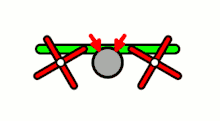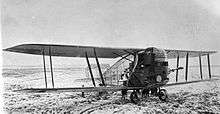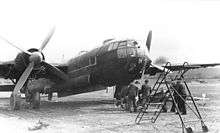Counter-rotating propellers
Counter-rotating propellers, also referred to as CRP, are propellers which spin in opposite directions to each other.[1] They are used on some twin- and multi-engine propeller-driven aircraft.



The propellers on most conventional twin-engined aircraft spin clockwise (as viewed from behind the engine). Counter-rotating propellers generally spin clockwise on the left engine and counter-clockwise on the right. The advantage of such designs is that counter-rotating propellers balance the effects of torque and P-factor, meaning that such aircraft do not have a critical engine in the case of engine failure.
Drawbacks of counter-rotating propellers come from the fact that, in order to reverse sense of rotation of one propeller, either the engines must be adapted to turn in opposite directions or one propeller must have an additional reversing gearbox.
History
Counter-rotating propellers have been used since the earliest days of aviation, in order to avoid the aircraft tipping sideways from the torque reaction against propellers turning in the a single direction. They were fitted to the very first controlled powered aeroplane, the Wright flyer, and to other subsequent types such as the Dunne D.1 of 1907 and the more successful Dunne D.5 of 1910.
In designing the Lockheed P-38 Lightning, the decision was made to reverse the counter-rotation such that the tops of the propeller arcs move outwards, away from each other. Tests on the initial XP-38 prototype demonstrated greater accuracy in gunnery with the unusual configuration.
The counter-rotating powerplants of the German World War II Junkers Ju 288 prototype series (as the Bomber B contract winning design), the Gotha Go 244 light transport, Henschel Hs 129 ground attack aircraft, Heinkel He 177A heavy bomber and Messerschmitt Me 323 transport used the same rotational "sense" as the production P-38 did – this has also been done for the modern American Bell Boeing V-22 Osprey tiltrotor VTOL military aircraft design. The following German World War II aviation engines were designed as opposing-rotation pairs for counter-rotation needs:
- BMW 801A and B, and G/H subtypes
- Daimler-Benz DB 604
- Daimler-Benz DB 606
- Daimler-Benz DB 610
- Junkers Jumo 222
The aerodynamics of a propeller on one side of an aircraft change according to which way it turns, as it affects the P-factor. This can in turn affect performance under extreme conditions and therefore flight safety certification. Some modern types, such as the Airbus A400M, have counter-rotating propellers in order to meet air safety requirements under engine-out conditions.
List of aircraft with counter-rotating propellers
| Type | Country | Date | Notes |
|---|---|---|---|
| Airbus A400M Atlas | EU | 2009 | Four engines |
| Beechcraft 76 Duchess | US | 1974 | Twin engines |
| Cessna T303 Crusader | US | 1978 | Twin engines |
| de Havilland Hornet | UK | 1944 | Twin engines |
| Dunne D.1 | UK | 1907 | twin engines in fuselage on a common driveshaft |
| Dunne D.4 | UK | 1908 | Single central engine |
| Dunne D.5 | UK | 1910 | Single central engine |
| Fairey F.2 | UK | 1917 | Twin engines |
| Gotha Go 244 | Germany | Twin engines | |
| Heinkel He 177A Greif (fourth prototype onwards) | Germany | Twin engines | |
| Henschel Hs 129 | Germany | Twin engines | |
| Junkers Ju 288 | Germany | Twin engines | |
| Linke-Hofmann R.I | Germany | 1917 | four engines in fuselage |
| Lockheed P-38 Lightning | US | 1939 | Twin engines |
| Messerschmitt Me 323 Gigant | Germany | Six engines | |
| North American P-82 Twin Mustang | US | Twin engines | |
| North American Rockwell OV-10 Bronco | US | Twin engines | |
| Piaggio P.180 Avanti | Italy | 1986 | Twin engines |
| Piper PA-31 Navajo (some variants) | US | Twin engines | |
| Piper PA-34 Seneca | US | Twin engines | |
| Piper PA-39 Twin Comanche C/R | US | Twin engines | |
| Piper PA-40 Arapaho | US | Twin engines | |
| Piper PA-44 Seminole | US | Twin engines | |
| Vought V-173 Flying Pancake | US | 1942 | Twin engines |
| Vought XF5U Flying Pancake | US | 1947 | Twin engines |
| Wright Flyer and most other Wright models to 1916 | US | 1903 | Single central engine. |
See also
- Tiltrotor
- Counter-rotating rotors
- Intermeshing rotors
- Screw-propelled vehicle – Vehicle propelled by load-bearing rotating helical flanges
References
- Notes
- Bibliography
- Gunston, Bill. Jane's Aerospace Dictionary. London, England. Jane's Publishing Company Ltd, 1980. ISBN 0 531 03702 9